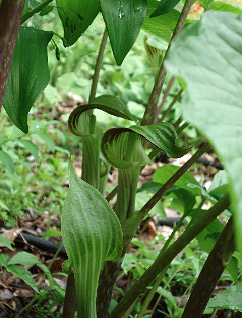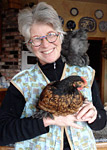home | internet service | web design | business directory | bulletin board | advertise | events calendar | contact | weather | cams

Inside the Deer Fence - May 20, 2010 By Jane Gilbertsen Dear Fellow Gardeners, It is raining buckets now. Jeez, I only write when it is raining. Why? Cause otherwise I am outside!  So too is Otto-ina, my RIR hen. She escapes daily outside the fence, lays an egg in the flower bed, walks over to the gate and hangs out til I let her back in. It is challenging to garden just outside the chicken fence. Not the greatest for keeping the flowers fluffy. However, I am trying to turn this problem into a solution elsewhere. I am planning on fencing in a section inside my deer fence to let the chickens do the quack grass removal. I think given time they would be the successful keeping all green shoots picked off. Theoretically, even the most tenacious plant denied photosynthesis long enough will give up or so says Dave Sabold. At least I hope so. Neither plastic, clear or black, nor RoundUP, has successfully wiped out quack grass for me. Only hand digging and picking out every tiny bit of root has worked. But maybe the chicken project will work well. I'll let you know next year if they leave the new space free of quack grass and well fertilized. So too is Otto-ina, my RIR hen. She escapes daily outside the fence, lays an egg in the flower bed, walks over to the gate and hangs out til I let her back in. It is challenging to garden just outside the chicken fence. Not the greatest for keeping the flowers fluffy. However, I am trying to turn this problem into a solution elsewhere. I am planning on fencing in a section inside my deer fence to let the chickens do the quack grass removal. I think given time they would be the successful keeping all green shoots picked off. Theoretically, even the most tenacious plant denied photosynthesis long enough will give up or so says Dave Sabold. At least I hope so. Neither plastic, clear or black, nor RoundUP, has successfully wiped out quack grass for me. Only hand digging and picking out every tiny bit of root has worked. But maybe the chicken project will work well. I'll let you know next year if they leave the new space free of quack grass and well fertilized. On another note, I planted my tomatoes. (Being lazy and loving the great selection at the Twisp Farmers Market I buy my starts.) I have to admit that between global climate change and the sincere advice of a young man bagger at Hanks, I am taking the risk of planting them before June 1. Any old long time local living in the valley would tell you to wait until June 1. I live near the Smoke Jumper Base and the garden is a bit above river level so we are not in the coldest possible spot in the valley. I am hanging tight to home this month anyway so I must stay aware of the temperature every night and promise myself I will institute heroic measures in the dark if necessary if I see the thermometer heading down. Many people believe that a frost is more likely during the full moon. We will have one from May 26-29. Cornell University studied 100 years of records in their area of upstate New York and did not find a relationship between frost and the lunar cycle. I do find it hard to fully dismiss rural wisdom in these things. So my plan is to be even more alert at the end of this month. The best heroic measure is to cover the plants and ensure that the cover does not actually touch the plants. The best cover is a woven material and the best time to cover is the late afternoon after the wind has died down. (Maybe it is also best cause you are not doing it in the dark when you are likely to step on or break your plants!) As soon as we have a break in the rain I am going to do some more planting of seeds and summer bulbs like gladiolus and the dahlia and canna tubers. If I am going to stress out on watching the temp I might as well do it for everything. Some years I get them up and going in pots in the greenhouse but I didn't get around to it this year. My soil is rather sandy so working it gently while it is wet is not fatal like is used to be in my old Seattle clay garden. There if you worked the soil when it was this wet, you turned it into adobe brick. The key is whether you can squeeze your soil in your hand and when you release your hand it crumbles nicely. If it sticks together in a ball, wait. Wait til it dries out somewhat. The less you trample or work wet soil the more you protect the texture of the soil. Texture is really really important. Texture helps the organisms keep your soil healthy and literally alive. Texture gives water a place to go and hang out til it is needed by the plant. Air requires an open texture. A healthy soil needs air exchange. Texture is the gift of worms and if you have read my stuff you will know how I feel about worms. I have been repairing damaged lawn areas from construction projects, fertilizing with whatever I have around (organic and not depending on the situation), pulling weeds and sneaky grass invaders, discovering new weeds and new weed aggressors, and finishing the winter cleanup projects.  I am including a picture of what is happening in my garden. This is the Jack in the Pulpit, Arisaema tryphyllum, beloved by native gardeners in the northern forest regions. It may have been taken out of the woods some 70 years ago or more but since then it has been happily seed propagated by nature at our family home. Nowdays, taking native plants from the wild when the plant site is not slated for development destruction, is considered unethical. Thankfully in our time of shrinking natural areas there is a code of ethical conduct for plant collectors, explorers and us regular people. I am including a picture of what is happening in my garden. This is the Jack in the Pulpit, Arisaema tryphyllum, beloved by native gardeners in the northern forest regions. It may have been taken out of the woods some 70 years ago or more but since then it has been happily seed propagated by nature at our family home. Nowdays, taking native plants from the wild when the plant site is not slated for development destruction, is considered unethical. Thankfully in our time of shrinking natural areas there is a code of ethical conduct for plant collectors, explorers and us regular people. One of the best things about gardening is remembering where plants came from - their place in the world, but also what garden, friend, trip or adventure brought them to your place. Sharing your plants with others spreads the joy and preserves them should you or others need them again. Anyway, every year Jack greets me, I remember my Grandmother. Lucky me.  In gratitude to the rain, Jane June 7, 2010 |